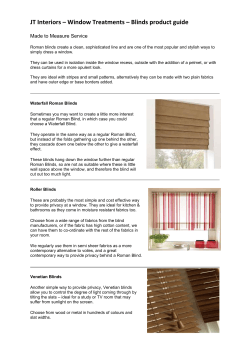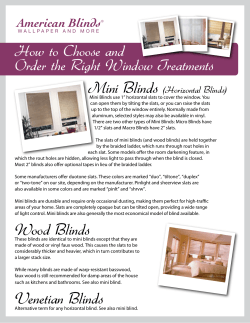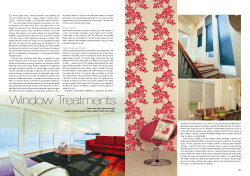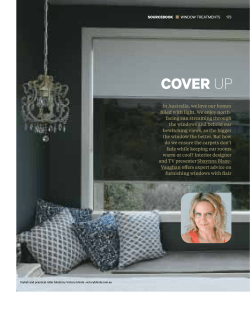
Window Treatment Horizontal Blinds Bali Cordless Mini Blinds PART 1—GENERAL
Springs Window Fashions LP Window Treatment Horizontal Blinds Bali Cordless Mini Blinds PART 1—GENERAL 1.01 DESCRIPTION A. Related Requirements 1. The Conditions of the Contract (General and Supplementary, and other Conditions), and Division 1 General Requirements (if any) are part of this section. (Delete or retain as appropriate.) INTERNAL CORD LIFT SYSTEM EXTENSION BRACKETS BRACKETS CRADLE AND DRUM 1.02 QUALITY ASSURANCE A. Job Mock-Up: (Describe) WAND 1.03 SUBMITTALS A. Manufacturer's Product Data: Submit manufacturer's descriptive product data and installation instructions for each type of blind specified. B. Shop Drawings: Submit shop drawings indicating the following: 1. Field-measured dimensions of openings scheduled to receive blinds. 2. Illustrations of special accessory components not included in manufacturer's product data. 3. Details of head and sill conditions, corner conditions, and conditions between adjacent blind units. C. Color Sample: Submit two 6" (0.15m) samples of material indicating full color range and color variation. D. Product Sample: Submit one 18" wide by 24" long fully functional sample blind. E. Maintenance Material (Extra Stock): (Describe) PART 2—PRODUCTS 2.01 HORIZONTAL BLINDS A. Manufacturer and Product: 1. Manufacturer: Springs Window Fashions LP a. Product: Bali Cordless Mini Blind. b. Options: (Describe) c. Color(s): Selected from Bali color standards. B. Product Description: 1. Aluminum Headrail: Headrail shall be 15⁄16" hight by 2" deep. The design of the headrail shall include a sculpted front and a light blocking lip at the lower back side. Typical extruded headrail wall thickness shall be .050" thick. 2. Head Channel Hardware: Hardware shall be low friction thermoplastic and guide lift cords and ladders in the head channel preventing wear and discoloration. Operating hardware shall be mechanically locked into head channel, by means of snap-in fittings with no mechanical cleats visible from underside of headrail. 3. Aluminum Bottomrail: Bottomrail shall be 1⁄2" high by 11⁄16" deep. Typical extruded bottomrail wall thickness shall be .055" thick. Blinds up to 597⁄8" wide will be treated with one acrylic bottomrail handle to raise and lower blind. Blinds 60" and greater will receive two handles. Bottomrail will be finished at each end with color-coordinated thermoplastic bottomrail end cap. Thermoplastic protective caps in bottom of rail shall be used to secure ladder ends. Hold-down bracket pins shall be available. 4. Slats: Slats shall be aluminum alloyed for maximum strength, flexibility and resistance to corrosion. Slats shall be nominally 1" wide, actual 0.991"(plus .004" or minus .000"). Standard thickness is 0.006", optional 0.008" is available. Standard color slats shall have a pre-coating treatment to bond the polyester baked enamel finish coat that features our Advanced Finishing Technology (AFT) which provides a smoother, harder, less porous surface that provides anti-static performance to help repel dust and anti-microbial qualities to help resist fungal and bacterial growth.Slat thickness and ladder support distances shall be such that there is no visible sag. a. Privacy Slat Option: Privacy slat option provides slats with offset rout holes and 18mm braided ladder spacing for enhanced light control. When slats are tilted down, rout holes are concealed by slat overlap. BRAIDED LADDER ALUMINUM SLAT BOTTOMRAIL HANDLE ALUMINUM BOTTOMRAIL HOLD-DOWN BRACKET Bali Cordless Mini Blind 5. Cradle and Drum: Cradle shall be injection molded nylon and shall provide a smooth bearing surface for the ladder drum. the ladder drum shall be acetal low friction thermoplastic and shall securely attach ladders. 6. Internal Cord Lift System: Cords shall be attached to traversing tube that prevents cords from overlapping each other. The weight of the blind shall be balanced by a spring motor. The spring motor shall be belt driven for smooth and quiet operation. A simple push or pull of an acrylic handle raises and lowers the blind. Blinds less than 60" wide will have one handle centered on the bottomrail. Blinds 60" or wider will have two handles appropriately spaced for two hand raising and lowering operation. 7. Shaft Type Tilter: The tilter shall be of a worm and gear arrangement in a totally enclosed gear case (housing). A built-in clutch mechanism begins to operate when slats are fully closed in either direction and rotation continues to be applied to the tilter. The tilter shaft shall be of clear polycarbonate; the gear of nylon and the gear housing of acetal thermoplastic. The tilter shall be designed for smooth, low friction operation. a. Tilt Wand: The tilt wand shall be a clear polycarbonate hollow rod, with a hexagonal shape measuring approximately 1/4" across the points, providing a positive, comfortable grip. The wand shall hang vertically by its own weight and should be of sufficient length for easy access and operation. Wand shall be attached to the tilter shaft by means of a steel clip and shall be easily detached and reattached in the field. 8. Braided Ladders (Slat Supports): Bali cordless mini shall have braided ladder which will assure proper control with adequate overlap of slats in the closed position. Distance between end ladder and end of slats will not exceed 61⁄2"; distance between braided ladders shall not exceed 24". a. Braided Ladder Material: Material shall be 100% high tenacity polyester yarn. Vertical component shall be not less than 0.045" diameter nor greater than 0.066-inch diameter, and shall provide maximum strength and flexibility with minimum stretch. Horizontal component, or rungs, shall be not less than two threads and shall be approximately 31.0mm long. Standard ladder will provide 21.5mm of distance between slats. Optional 20mm spacing is available. Ladders shall be of sufficient length for bottom of blind to hang with a tolerance of plus one-half/minus zero inches of the specified length. Ladders shall be dyed to Bali color standard. Window Treatment Horizontal Blinds Bali Cordless Mini Blinds 9. Lift Cords: Lift cords shall be braided with polyester jacket and center core or an approved equal construction. Size of cord shall be .9mm. Cord ends shall be securely anchored to the bottomrail. Cording arrangements shall comply with assembly standards set for the size and weight of the blind. Cords shall be dyed to color standard. 10. Tilter Operation Locations: 1) Tilter at left (standard). 2) Tilter at right (reverse). 11. Installation Brackets: Top loading hidden brackets are made of brass plated steel. Brackets shall allow adequate space to accommodate power screwdriver for mounting. The brackets shall facilitate easy installation and removal of head channel. Each bracket shall be installed with a minimum of 2 installation screws. 12. Intermediate Support Brackets: Brackets shall be furnished for blinds over 60" wide. Maximum spacing for intermediate support brackets shall be 48". 13. Extension Brackets: Optional extension brackets are available. 14. Hold-Down Brackets: Optional universal hold-down brackets for sill or jamb installations are available. 15. General: The blind shall be free of sharp edges, burrs or other defects which might be harmful. When other materials result in improved specifications, they may be adopted. 16. Size Limitations: a. Single blinds on one headrail: Maximum blind size is 6400 square inches. Within this range, headrail width may be 18" to 96" exact. Height may be 12" to 84" exact. b. Privacy blinds on one headrail: Maximum blind size is 5900 square inches. Within this range, headrail width may be 18" to 96" exact. Height may be 12" to 72" exact. c. Multiple blinds on one headrail: Maximum headrail width is 144". Each individual blind width may be between 18" and 60" exact. Height may be 12" to 72" exact. 17. Color: Color of headrail, bottomrail, ladder, cord and plastic accessories shall coordinate with slats. PART 3—EXECUTION 3.01 INSPECTION: Verify that the work area in which the blinds will be installed is free of conditions that interfere with blind installations and operations. Begin blind installation only when unsatisfactory conditions have been corrected. 3.02 INSTALLATION A. Install blinds in accordance with manufacturer's procedures except as otherwise specified herein. B. Install intermediate support brackets and extension brackets as needed to prevent deflection in headrail. C. Install blinds with adequate clearance to permit smooth operation of blinds. D. Demonstrate blinds to be in smooth, uniform working order. 3.03 CLEANING A. Clean soiled blind surfaces with a mild soap solution. Do not use steam, hot water, bleach or any abrasive or solvent-based cleaners. Do not wash metallic colors. 3.04 HORIZONTAL MINI BLIND SCHEDULE: Provide blinds at the following locations: (listing of blind locations, different options, types, accessories and colors). 2.02 FABRICATION A. Prior to fabrication, verify actual opening dimensions by on-site measurement. Calculate blind dimensions to fit within specified tolerances. B. Fabricate blinds to fill openings from head to sill and jamb to jamb. Locate blind divisions at mullions. C. Fabricate blinds to fill all exterior window openings except at doors, door sidelights and transoms unless noted. Window Fashions LP P.O. Box 500, Montgomery, PA 17752 Part No. 21-0898-16 (12/02)
© Copyright 2025





















